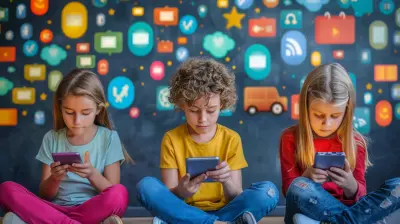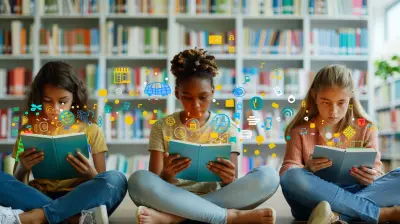How to Teach Students to Synthesize Information From Texts
11 October 2025
Let’s be real—teaching students to understand what they read is already a feat. But teaching them to synthesize information? That’s next level. It’s kind of like helping them take puzzle pieces from different boxes and create a whole new picture that makes sense. Sounds tricky, right? But here’s the thing—once students learn how to synthesize, they don’t just understand texts better, they start thinking critically and making meaningful connections. And that’s gold in any classroom.
In this article, we’re going to break down how to teach students to synthesize information from texts in a way that’s practical, engaging, and totally doable—whether you’re teaching in-person or online.
What Does It Mean to Synthesize Information?
First off, let’s get on the same page. What exactly is synthesizing information?Well, it’s more than just summarizing. When students summarize, they repeat what the text says. But when they synthesize, they take bits and pieces from multiple texts or sources, mix them with what they already know, and form new ideas or insights.
Think of it like making a smoothie. Summarizing is just naming ingredients. Synthesizing? That’s blending it all into something new and delicious.
Why Synthesis Matters in Today’s Classrooms
You might be thinking, “This sounds nice, but is it really necessary?” Oh yes—it’s essential.Here’s why:
- We live in an information-heavy world. Students are bombarded with data—news, blogs, videos, tweets—you name it.
- Critical thinking is key. Employers, colleges, and, well, life demand the ability to evaluate and connect information.
- Standardized tests love synthesis. Seriously, synthesis skills are baked into reading assessments, essays, and research projects.
In short, if you’re prepping your students for real-world success, synthesis isn’t optional—it’s a must.
Step-by-Step: How to Teach Students to Synthesize Information From Texts
Now that we know why it matters, let’s dive into the how. Here’s a step-by-step guide that works across grade levels.1. Start with the Basics: What Is Synthesizing?
You wouldn’t throw someone into a pool without floaties, right? Same goes here. Before expecting students to synthesize, help them understand what it is in kid-friendly terms.You might say:
> "Synthesizing is like being a detective. You take clues from different places and put them together to solve a bigger mystery."
Or:
> "It’s like being a chef. You take ingredients (facts and ideas), mix them up, and cook up something brand new!"
Use visuals. Anchor charts. Real-life examples. Make it stick.
2. Model the Process (And Think Aloud While You’re Doing It)
If you want your students to synthesize, you’ve got to show them how you do it first.Pick two short, related texts. For instance, one article on climate change and another on renewable energy. Then read them aloud and talk through your thinking:
> "Okay, this article says that burning fossil fuels leads to climate change. The second one talks about solar power as a cleaner energy source. So, I’m thinking... using solar power could help reduce climate change. That’s a new idea I didn’t have before!"
This shows students the mental moves they need to make. You’re not just reading—you’re connecting, analyzing, and creating.
3. Use Think-Pair-Share to Build Confidence
After you model, throw it back to your students—but in pairs. Let them practice synthesizing together using Think-Pair-Share.Give them two texts and a guiding question like:
> "What new idea can you come up with after reading both texts?"
Students think on their own, discuss with a partner, then share with the class. This builds confidence and reinforces critical thinking.
4. Introduce Graphic Organizers
Graphic organizers are a synthesizer's best friend. They help students organize their thoughts before writing or discussing.Here are a few tried-and-true ones:
- Double Bubble Map – Compare and contrast two texts.
- Synthesis Chart – List key info from Text #1, Text #2, prior knowledge, then synthesize a new idea.
- Venn Diagram – A classic way to highlight similarities and differences.
Pro tip: Keep the design simple—no bells and whistles. The point is to help students process the info, not get lost in decoration.
5. Use Multiple Texts with a Common Theme
To truly teach synthesis, your students need multiple perspectives. Choose 2-3 short texts on the same topic but from different viewpoints.Example topics:
- The effects of social media on teens
- Pros and cons of school uniforms
- Climate change from a scientific vs. economic angle
Ask questions like:
- “What’s a common idea all authors agree on?”
- “Where do they differ?”
- “What new idea comes from reading all of these together?”
This pushes students to go beyond surface-level thinking.
6. Make It Interactive with Jigsaw Activities
Ever tried a jigsaw classroom activity? They’re perfect for synthesis.Here’s how it works:
1. Divide students into groups and assign each person a different text.
2. Let them become “experts” on their assigned text.
3. Mix groups so each new group has one member from each text.
4. Students teach each other what they learned.
5. Then, as a group, they synthesize: “What new understanding do we have now that we know all angles?”
It’s collaboration + comprehension = deep synthesis.
7. Connect Synthesis to Writing
Once they’ve synthesized information, get them to write about it. This is where real thinking happens.You could ask:
- “What’s your opinion after reading these texts?”
- “Write an argumentative paragraph using evidence from both texts.”
- “How did your thinking change after reading all the sources?”
Teaching synthesis through writing helps cement the skill—and hits curriculum standards too.
8. Teach Students to Spot Bias and Evaluate Sources
This one’s big, especially for older students.When synthesizing, not all information is created equal. A blog by someone’s cousin isn’t the same as a peer-reviewed study. Teach students to ask:
- “Who wrote this?”
- “What’s their purpose?”
- “Do they have evidence or just opinions?”
This way, their synthesis will be more informed, balanced, and accurate.
9. Use Real-World Topics to Boost Engagement
Want to keep students engaged? Use topics they care about.- Is TikTok helpful or harmful?
- Should school start later?
- How does climate change affect their community?
When students are emotionally invested, they’re more likely to dig deep, analyze, and really synthesize.
10. Practice, Practice, Practice (And Celebrate Progress!)
Synthesis isn’t something students master after one lesson. It takes time. So build it into your routine.Use short daily synth prompts. Pair texts often. Have reflection journals. Use peer feedback.
And don’t forget to celebrate the small wins. When a student shares a thoughtful insight, call it out. Let them know they’re thinking like scholars.
Common Challenges and How to Tackle Them
Even with all these tips, synthesis can be tricky. Here are a few bumps you might hit—and how to smooth them out.“I Only Read One Text…”
Students often default to the most familiar source. Remind them: synthesis = multiple sources. Use exit tickets to check that they’ve used at least two.“They Just Copy/Paste Information”
Teach them to put it in their own words. Try an “Explain It to a Friend” strategy. If they can explain it simply, they get it.“They Miss the Big Picture”
Guide them with questions like:- “So what?”
- “Why does this matter?”
- “What does this mean in real life?”
These push students beyond facts into meaning.
Final Thoughts
Synthesis is one of those superpowers that sticks with students for life. It’s not just a reading or writing skill—it’s a thinking skill. When students learn how to pull ideas from different texts and mold them into something new, they become stronger readers, sharper writers, and more thoughtful human beings.Start small. Keep it simple. Make it real. And keep pushing your students to think bigger.
You’ve got this—and so do they.
all images in this post were generated using AI tools
Category:
Reading ComprehensionAuthor:

Monica O`Neal
Discussion
rate this article
1 comments
Kingston McVaney
Synthesizing information is crucial for critical thinking; educators must provide structured guidance and diverse texts to enhance students' analytical skills.
October 14, 2025 at 11:15 AM

Monica O`Neal
Thank you for your insightful comment! I completely agree that structured guidance and a variety of texts are vital in helping students develop their synthesis and analytical skills.


